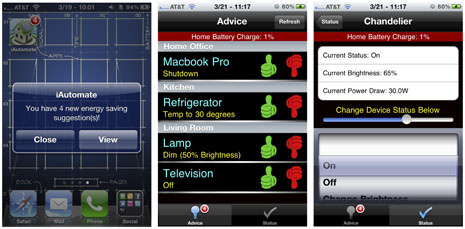
FAYETTEVILLE, Ark. – Technology just made being “green” easier. Computer science researchers at the University of Arkansas and University of San Francisco have developed an automated energy-management system that monitors energy generation and consumption in off-grid and grid-tied homes that use solar energy or wind power. As part of the system, an iPhone application warns homeowners of critical battery situations, suggests appliances to turn on or off, recommends ideal times to execute tasks that require greater power and adjusts power states of devices to reduce energy consumption.
“We’ve built a system that strikes a balance between totally automated control, which might irritate homeowners by turning off the television while they’re watching a program, and reactive or manual techniques that really are not sufficient to prevent critical battery situations or energy outages,” said Nilanjan Banerjee, assistant professor of computer science and computer engineering at the University of Arkansas. “Our system simply alerts the homeowner of critical situations and then suggests which appliances to turn off. From anywhere, as long as they have their smart phone, homeowners can then use the software to direct the system to shut off the suggested appliance or a different one.”
Banerjee, Pat Parkerson, associate professor of computer science and computer engineering at the University of Arkansas, and Sami Rollins, professor at the University of San Francisco, installed a suite of monitoring tools in an off-grid, solar-powered home in Fayetteville, Ark. The researchers collected generation and consumption data for 55 days, 14 days during the summer of 2010 and 41 days in November and December of 2010. In addition to monitoring power-generation devices of the photovoltaic system, their system also tracked individual appliances, including a refrigerator, washer and dryer, hot-water heater and even a television and lamps.
Data collected by the monitoring system demonstrated important findings. First, energy harvested from the solar panels and energy consumed by the house were both highly variable. This was true within a single day, across several days and across seasons. Although generation and consumption varied greatly, they did so in a predictable manner.
Second, the study demonstrated that traditional energy-management techniques are insufficient in off-grid homes. The widespread assumption is that the ideal time to run appliances that require a lot of energy is between 7 p.m. to 7 a.m. However, the researchers discovered that considering the state of the battery, it was better to run appliances during the day – 10 a.m. to 8 p.m. Finally, the data showed that manual and reactive techniques do not prevent critical battery situations. The homeowner in the study was conservative with energy consumption and carefully monitored battery voltage. Still, he had to rely on a backup generator approximately 25 percent of the time because he could not predict times in which harvesting solar energy was low.
“All of these findings point to the need for a feasible, automated, proactive energy-management scheme,” Banerjee said.
 This prototype measurement system in an off-grid home in Arkansas helps the researchers understand how energy is generated and consumed in homes powered by renewable sources. |
The control system performs three important tasks. It predicts when a home’s energy storage is likely to be critically low and notifies users/homeowners in advance so they may take proactive measures to reduce consumption. Also, by predicting when energy harvested is at its peak, the system advises users/ homeowners of ideal times to execute tasks, such as running a dishwasher or clothes washer, that require a lot of power. Relying on information collected on each appliance, the system suggests energy conservation. For example, based on information provided by the system, users could adjust or reduce the temperature of the refrigerator by a few degrees without negatively affecting its performance.
The researchers have expanded the project to sharpen their understanding of performance of specific appliances. Parkerson is designing hardware circuits with sensors to better monitor and control individual devices and appliances. This will enable the researchers to understand why specific appliances consume energy the way they do. Although they have not yet analyzed new data, the researchers predict that it relates to ambient light and ambient temperature, both inside and outside the house.
“Our goal now is to try to understand why energy is used the way it’s used,” Banerjee said.
The researchers are seeking additional off-grid and grid-tied homes for further studies. The information they collect will remain anonymous, and volunteer participants will receive a free system application to monitor and manage energy within their homes.
Off-grid homes account for only 1 percent of all dwellings in the United States. However, the research also applies to grid-tied homes – homes that produce their own power but are also connected to the grid – and may help these homeowners receive tax rebates or possibly sell energy back to power companies. In the United States, the number of grid-tied homes with solar power grew by 40 percent in 2009. In addition to tax rebates and selling energy back to power companies, off-grid and grid-tied homes decrease reliance on fossil-fuel energy production and do not harm the environment because they rely on clean energy sources such as sun and wind.
To learn more about this project, go to the System Support for Green Homes webpage.
Topics
Contacts
Nilanjan Banerjee, assistant professor
Computer Science and Computer Engineering
479-575-4382, nilanb@uark.edu
Matt McGowan, science and research communications officer
University Relations
479-575-4246,
dmcgowa@uark.edu